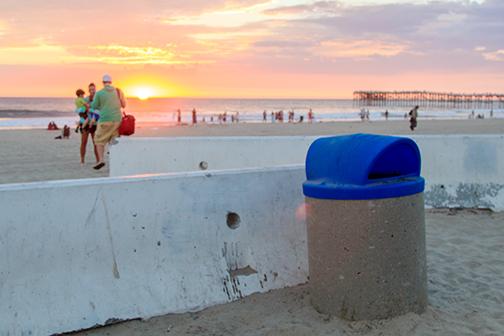The National Resources Defense Council published a report revealing California spends nearly half a billion dollars on coastal cleanup. San Diego placed second on a list of top 10 cities—spending more than $14 million on cleanup efforts.
The report, released on Aug. 28, detailed the real costs of litter cleanup throughout the state. The research emphasizes the importance of the amount spent for waterway cleanup and its relationship to tight budgets throughout California.
The report makes the case for a more egalitarian burden of costs of water waste management between taxpayers, local governments, and plastic bottle producers.
The report examined 95 communities across the state, ranging in population size and proximity to the ocean, listing the top 10 cities with the most money allocated for the removal of waste in its waterways. The city spending the most on its waterway cleanup is Los Angeles, allocating $36.3 million per year.
Other cities in the top 10 are, in chronological order, Long Beach spending $12.9 million; San Jose spending $8.8 million; Oakland $8.3 spending million; Sacramento spending $2.8 million; Hayward and Merced spending $2.3 million; Redondo Beach spending $2.1 million and South Gate spending $1.7 million.
San Diego State assistant professor of anthropology and faculty member in the sustainability program Frederick Conway said NRDC’s take on this problem is what is needed to solve it.
“The National Resources and Defense Council having the idea of developing a coalition, which includes the waste management people as well as business groups, as well as environmental groups, community members, is just the kind of approach that the complexity of such a problem really calls for,” Conway said.
Conway said the magnitude of this problem requires many different factors to come together to solve the problem, working toward practical solutions rather than imposing regulations.
“One of the issues with this kind of complex problem of litter and particularly material that finds itself into waterways and water sheds along the coast, is it involves so many different kinds of people,” Conway said. “It involves the manufacturers, it involves the users, it involves many different levels of government, city, state, federal, county, all of whom are involved in these different kinds of areas.”
SDSU psychology and environmental studies senior Kristian Salgado said the problem can be solved by looking for a solution that addresses the root of the problem.
“I think we should concentrate efforts on prevention before cleanup,” Salgado said. “So maybe tighter recycling systems, more education, so it doesn’t have to become this constant cleaning of a mess. If you’re constantly cleaning it up … you will be doing that forever, it’s not going to end.”
Salgado works with SDSU’s PowerSave Green Campus program, which promotes sustainability projects in the university.
Other SDSU organizations have participated in coastal cleanups around San Diego. The SDSU Surfrider Foundation club has made efforts to clean beaches in the past, along with the SDSU Student Accounting Society, which cleaned multiple beaches and riverbanks last spring semester.
Additionally, Associated Students Green Love has also held recycling events.
The NRDC is a nonprofit organization and was founded in 1970 by a group of law students and attorneys with interest in environmental protection. The NRDC is headquartered in New York City and has offices in Washington D.C., San Francisco, Montana, Beijing, Santa Monica and the Midwest.
Its staff consists of more than 300 professionals in fields such as law, sciences and policy.
See a breakdown of costs by city.
Update: The sentence, “The National Resources Defense Council published a report revealing California spends nearly half a billion dollars on coastal cleanup” incorrectly said million instead of billion.







